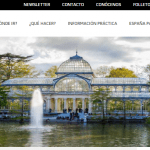A journey through 56 tourist destinations across Spain and the world to tackle digital transformation.
The Guide for Best Practices in Digitalisation for Smart Destinations, created by SEGITTUR, consists of a journey through 56 tourist destinations across Spain and the world to tackle digital transformation.
The guide was presented today by the Chairman of SEGITTUR, Enrique Martínez Marín, to the Smart Destinations Network. It is based on work carried out with the destinations and the industry on the main challenges the destinations have faced relating to the adoption of technological tools and on research into best practices and solutions in destinations across the world and within the Smart Destinations Network itself.
In total, 11 challenges have been identified that the destinations have come across on their journey to becoming Smart Destinations. These are linked both to interactions with visitors throughout their holidays (increasing tourist spending and loyalty, for example) and to local management (such as strengthening public-private cooperation and dealing with public services being overwhelmed by tourism), and include three specific challenges relating to managing the health crisis.
The guide includes best practices found around the world, in destinations such as Abu Dhabi, Amsterdam, Antakya, Antwerp, Auckland, Buenos Aires, Cape Town, Dubrovnik and Florence, as well as Spanish destinations like Marbella, Murcia, Palma de Mallorca, Salou, San Sebastián and Santa Susanna.
The guide categorises the best practices by the challenges that they help to tackle, grouped into four usage scenarios for digital tools: tourist management throughout the trip, local public management, the destination’s digital capacities and the management of the health crisis resulting from COVID-19. The best practices described help tackle one or more of the challenges faced by Smart Destinations.
Managing the overcrowded Dubrovnik old town in real time; virtual immersion in Slovenia; managing queues through smart ticket sales in Florence; using data to anticipate trends in Germany; managing the cleaning and safety of beaches in Auckland; public safety sensors to avoid fights in Eindhoven; and analysing travellers using geo-location are just some of the international best practices included.
In Spain, noteworthy examples include smart signs in Conil de la Frontera; crowd behaviour analysis in Barcelona; the use of Artificial Intelligence to get to know tourists in Marbella and to measure capacities in Salou; people-counting sensors in Santander; smart beaches in the Balearic Islands, Barcelona, Benidorm, Gandía and Salou; monitoring properties used for tourism; and the virtual tourist offices in the Region of Valencia.
The guide can be downloaded from the SEGITTUR website





